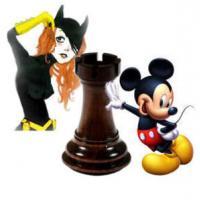
A Bat, A Mouse and a Castle
She-Who-Flies-by-Night is known well beyond the boundaries of chess.com and is one of the most respected contributors in the chess firmament, so when she makes a request it carries the authority of a royal command. A few days ago she asked me to write a story about castle mates and I didn't even stop to say, Yes ma'am—I went straight off, searching for them.
As you'd expect, the majority of such games—in which mate is achieved by castling—are only possible when a Master plays an amateur; as a result, most of the victims are anonymous. That's where the mouse comes in—Anonny Mouse.
Batgirl herself supplied one example from twelve year-old Paul Morphy who was brave enough to castle mate his father. If any of my kids had done that to me they'd have been grounded for life! You can find the game in the comments section of my “King Hunts” story.
The game in the first diagram below was originally published by Eugene Znosko-Borovsky in The Art of Chess Combination and repeated by Robert Timmer in his entertaining book Castling to Win. There was a sense of inevitability about this game and Mr Mouse must have felt like a bulimic dieter on a binge. He'd have liked to stop eating but White kept feeding him pieces and he couldn't say no.
In the second game the Mouse had the white bits against Dr Meyer at Ansbach in 1931. Unlike the previous game he wasn't fed too much cheese—Meyer sacrificed only a rook—but at the end of play the body of the board was dominated by Black while the White pieces cringed on the first rank wringing their hands and, like the Scots of old, pleading in vain with Bonnie Charlie to come home.
There's no Mouse in Game 3—Annony Mouse or otherwise—but since the game was won by Seuss, playing against Hurme, at the 1969 Students' Olympiad at Dresden, you might wonder whether The Cat in the Hat was lurking behind White's pieces, or whether perhaps, Hurme just had a case of bats in the belfry. And, before anybody takes the trouble to point it out, a simple 19.Rf1# would have sufficed, but castling had a lot more panache. This is a different kind of castle mate but no less entertaining.
There's a timeliness about this topic. When batgirl suggested it I went looking for some castle mates and hadn't found any before the postman arrived on Wednesday with a box of books from the USCF. They included the freebie offered in the joint promotion with chess.com and until I opened the box I had no idea what to expect. It turned out to be Robert Timmer's Castling to Win—a fascinating read with a few pages on castle mates. Thank you USCF!
(Postscript: I wrote this piece on Thursday, the day before batgirl posted The Morals of Chess so my opening remarks were not intended as a response to that post. They expressed my opinion at the time of writing. I haven't changed my mind.)

